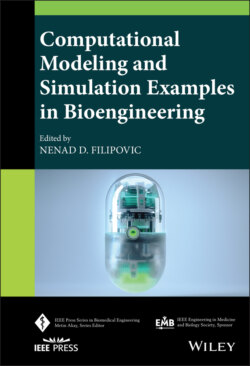Читать книгу Computational Modeling and Simulation Examples in Bioengineering - Группа авторов - Страница 25
1.8 Data Mining and Future Clinical Decision Support System
ОглавлениеTogether with CFD simulation, there are numerous statistics‐based machine learning methods that can be used to give more accurate and faster conclusions for clinicians [117].
Kolachalama et al. [118] proposed a DM technique that accounted for the geometric variability in patients for predicting cardiovascular flows. A Bayesian network‐based algorithm was used to understand the influence of key parameters through a sensitivity analysis. Martufi et al. [119] investigated a geometrical characterization of the wall thickness distribution in AAA. They were able to train a model to differentiate the wall thicknesses in ruptured and un‐ruptured AAA. Shum et al. [120] developed a model from 66 ruptured data sets and 10 non‐ruptured data sets and their geometric indices and wall thickness variations. The results of this study showed that, in addition to maximum diameter, sac length, sac height, volume, surface area, bulge height, and ILT volume were all highly correlated with rupture status. In this study, the overall classification accuracy was 86.6%. It used a decision tree algorithm that is one of the possible machine learning methods that can be used for large data sets requiring a decision output.
Filipovic et al. [121] combined DM techniques and CFD for the estimation of the wall shear stresses in AAA under prescribed geometry changes. They performed large‐scale CFD runs for creating machine learning data on the Grid infrastructure and their results showed that DM models provide good prediction of the shear stress at the AAA in comparison with full CFD model results on real patient data.
The abovementioned studies have been limited by the use of geometric parameters and, in particular, the maximum diameter of lumen alone as factors contributing to the rupture of an AAA. But other parameters such as patient history and comorbidities and presence of stents or other geometric parameters such as the aneurysm neck angles, tortuosity, and genetics factors [122–126] should be included. Despite the fact that state‐of‐the‐art FEM approaches represent powerful tool for estimation of AAA, their application in clinical practice remains limited due to several reasons. Firstly, every patient has specific and complex anatomy and it is not possible to create a general or parametric human model. Moreover, accuracy of simulations depends on the considered level of details, meaning that increasing required computation time and power will be necessary for obtaining precise results. As a consequence, performing patient‐specific simulation may take a few hours (if patient scans are available in the first place). This makes current FEM approaches inadequate for urgent situations such as alerting patient in case of AAA rupture.
In order to avoid described limitations, the patient‐specific DSS could be proposed. The main idea is to perform patient‐specific forward simulations in advance. AAA of different types (sizes and positions) will be simulated and calculated stress analysis will be used for training of intelligent model. But, in order to perform forward FEM simulations patient geometry is required. For this reason, during the registration into our system, in local workstation (user hospital), patient or his/her medical institution will be asked to provide us patients' medical scans (CT or MRI for example), if there are any. However, it is assumed that some patients will not have medical scans.
For future clinical DSS, we suggest the following scenario: new user has already performed medical scanning (CT or MRI) and these data are uploaded to the central server (or they are available over institution existing connection). In that case, we will generate 3D patient‐specific FEM model by using image‐based modeling software developed on the server. It is important to mention that, for the project purposes, accurate reconstructions will be necessary only for torso and aorta. We will reconstruct only aorta (by using statistical shape models) and torso interface (by using level set and marching cubes algorithms) because they are needed for setting FEM boundary conditions and because, on the other hand, accurate reconstruction of all organs represents time‐consuming and computationally expensive problem with current medical imaging methods. In this way, highly accurate geometry, materials, and boundary conditions could be obtained for every patient (Figure 1.4).
Figure 1.4 Description of clinical decision support system for AAA disease.
